Flynn’s Taxonomy
Single instruction stream, single data stream (SISD)
Single instruction stream, multiple data streams (SIMD)
Vector architectures
Multimedia extensions
Graphics processor units
Multiple instruction streams, single data stream (MISD)
No commercial implementation
Multiple instruction streams, multiple data streams (MIMD)
Tightly-coupled MIMD
Loosely-coupled MIMD
Introduction
SIMD architectures can exploit significant data-level parallelism for:
Matrix-oriented scientific computing
Media-oriented image and sound processors
SIMD is more energy efficient than MIMD
Only needs to fetch one instruction per data operation
Makes SIMD attractive for personal mobile devices
SIMD allows programmer to continue to think sequentially
SIMD Parallelism
Vector architectures
SIMD extensions
Graphics Processor Units (GPUs)
For x86 processors:
Expect two additional cores per chip per year
SIMD width to double every four years
Potential speedup from SIMD to be twice that from MIMD!
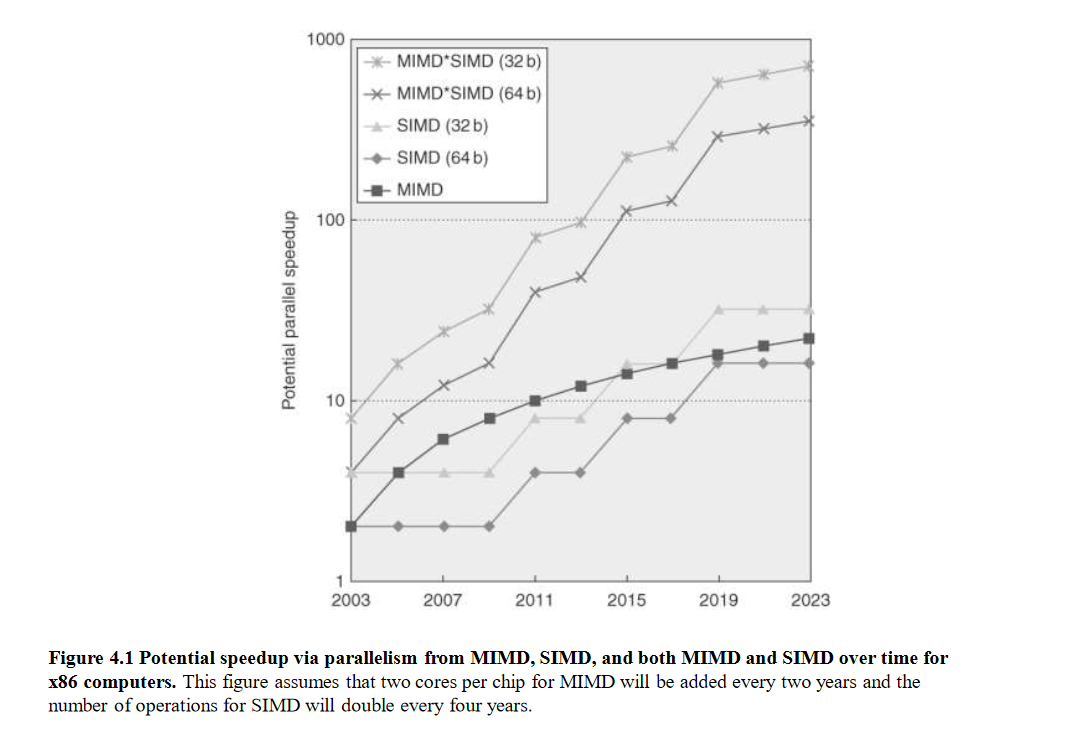
Fig 1 – Potential speedup via parallelism from MIMD,SIMD and both MIMD and SIMD over time for x86 computers
Vector Architectures
Basic idea:
Read sets of data elements into “vector registers”
Operate on those registers
Disperse the results back into memory
Registers are controlled by compiler
Used to hide memory latency
Leverage memory bandwidth
VMIPS
Example architecture: VMIPS
Loosely based on Cray-1
Vector registers
Each register holds a 64-element, 64 bits/element vector
Register file has 16 read ports and 8 write ports
Vector functional units
Fully pipelined
Data and control hazards are detected
Vector load-store unit
Fully pipelined
One word per clock cycle after initial latency
Scalar registers
32 general-purpose registers
32 floating-point registers

Fig 2 – The basic structure of a vector architecture VMIPS
VMIPS Instructions
ADDVV.D: add two vectors
ADDVS.D: add vector to a scalar
LV/SV: vector load and vector store from address
MULVV.D: multiply two vectors
MULVS.D: multiply a vector with a scalar
SUBVV.D: subtract vector from a vector
SUBVS.D: subtract scalar from a vector
SUBSV.D: subtract vector from a scalar
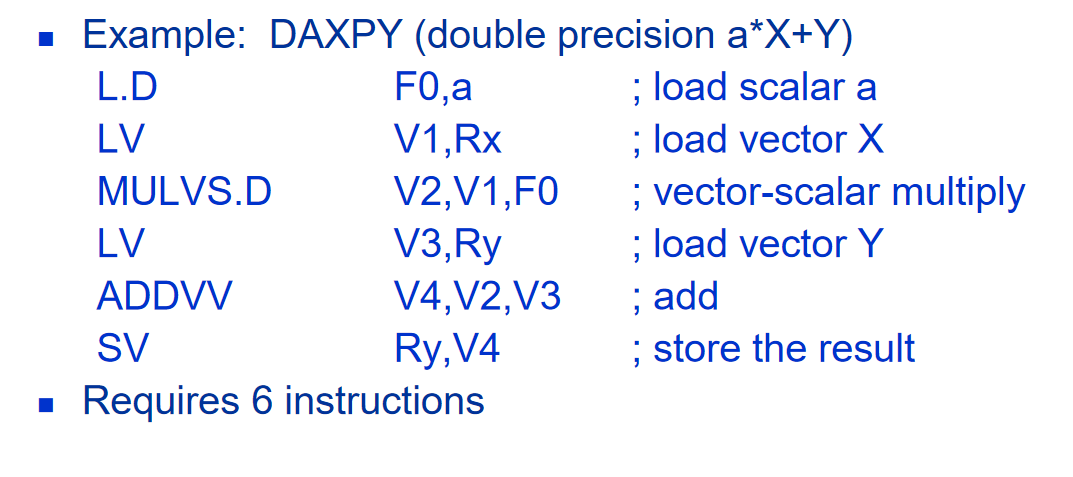
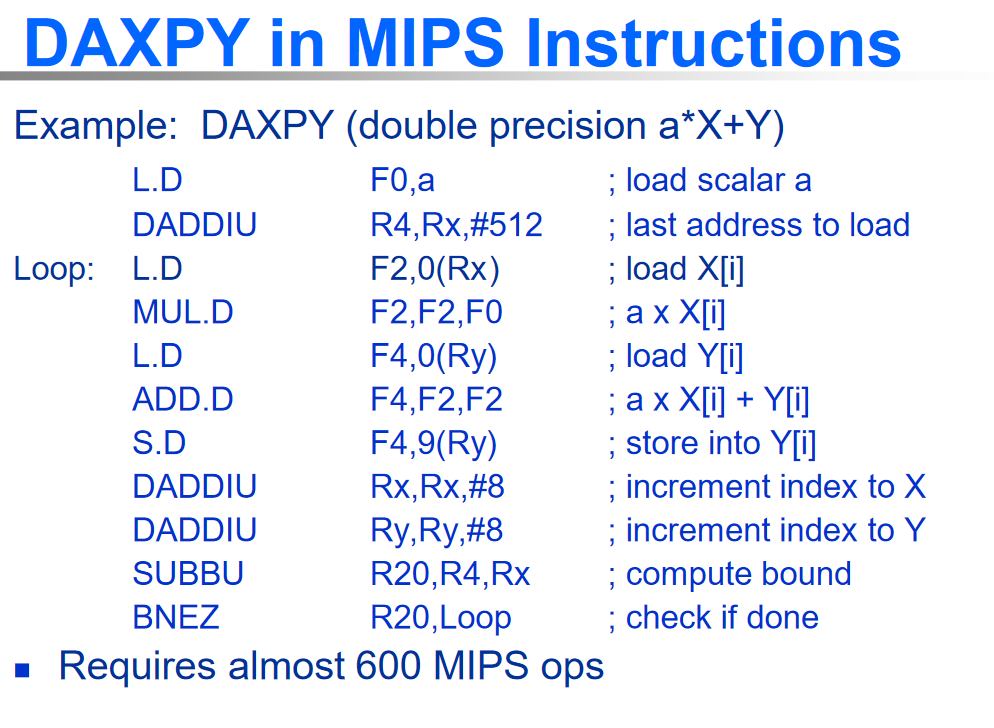
Vector Execution Time
Execution time depends on three factors:
Length of operand vectors
Structural hazards
Data dependencies
VMIPS functional units consume one element per clock cycle
Execution time is approximately the vector length
Convoy
Set of vector instructions that could potentially execute together
Chimes
Sequences with read-after-write dependency hazards can be in the same convey via chaining
Chaining allows a vector operation to start as soon as the individual elements of its vector source operand become available
Chime
Unit of time to execute one convey
M conveys executes in m chimes
For vector length of n, requires mx n clock cycles
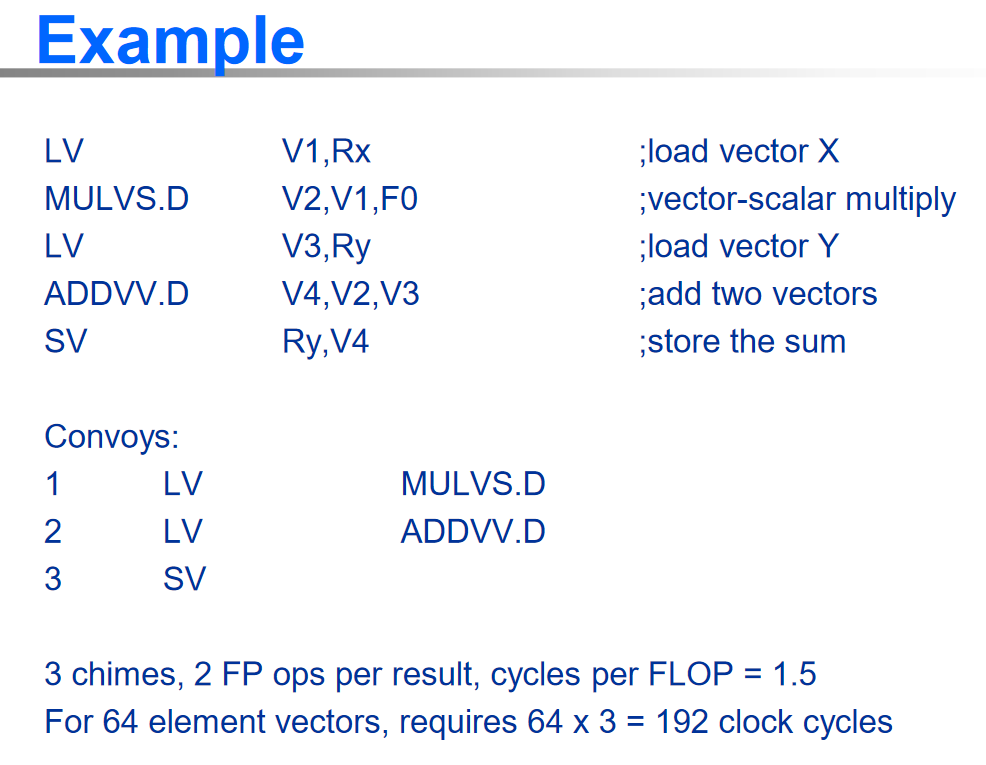
Challenges
Start-up timeLatency of vector functional unit
Optimizations:
Multiple Lanes: > 1 element per clock cycle
Vector Length Registers: Non-64 wide vectors
Vector Mask Registers: IF statements in vector code
Memory Banks: Memory system optimizations to support vector processors
Stride: Multiple dimensional matrices
Scatter-Gather: Sparse matrices
Programming Vector Architectures: Program structures affecting performance
Multiple Lanes
Element n of vector register A is “hardwired” to element n of vector register B
Allows for multiple hardware lanes
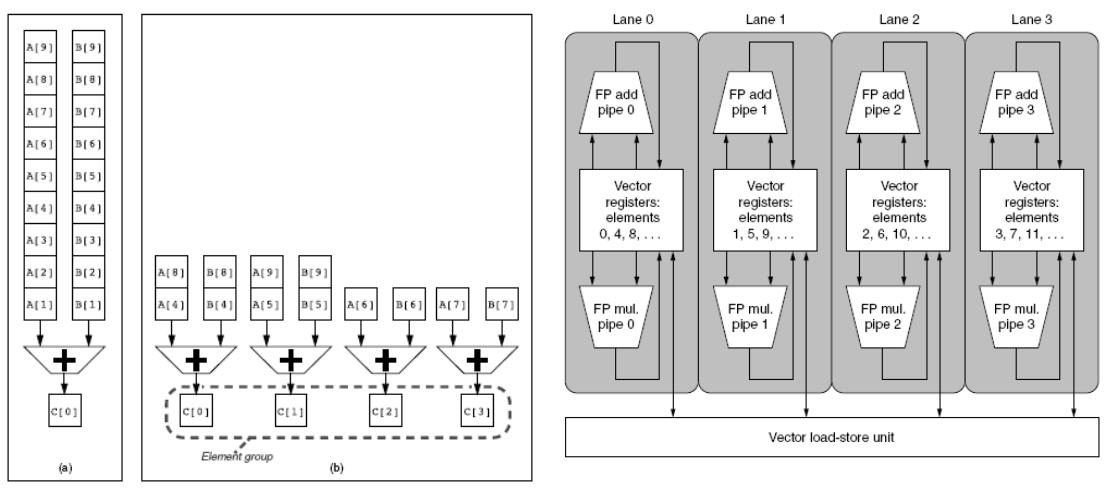
Fig 3 – Vector load store unit
Vector Length Registers
Vector length not known at compile time?
Use Vector Length Register (VLR)
Use strip mining or vectors over the maximum length
For shorter vectors, we can use a vector length register applied to each vector operation
For longer vectors, we can split the long vector into multiple vectors (of equal, or of maximum plus smaller lengths). The process is called strip-mining.
The strip-mined loop consists of a sequence of convoys.
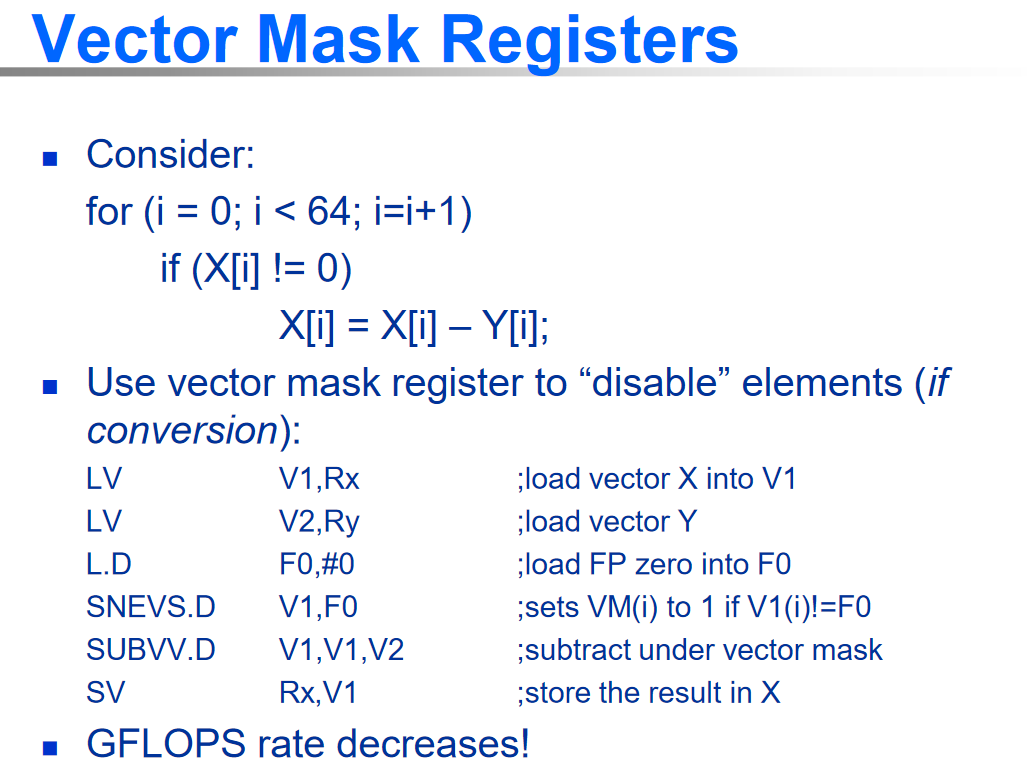
Memory Banks
Memory system must be designed to support high bandwidth for vector loads and stores
Spread accesses across multiple banks
Control bank addresses independently
Load or store non sequential words
Support multiple vector processors sharing the same memory
Example:
32 processors, each generating 4 loads and 2 stores/cycle
Processor cycle time is 2.167 ns, SRAM cycle time is 15 ns
How many memory banks needed?
32x6=192 accesses,
15/2.167≈7 processor cycles
1344!
Stride
Stride is the distance separating elements in memory that will be adjacent in a vector register. The unit stride is easiest to handle.
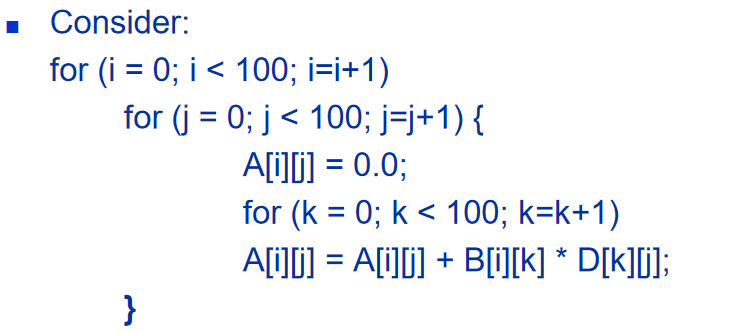
Must vectorise multiplication of rows of B with columns of D
Use non-unit stride
Bank conflict (stall) occurs when the same bank is hit faster than bank busy time:
Example:
8 memory banks with a bank busy time of 6 cycles and a total memory latency of 12 cycles. How long will it take to complete a 64-element vector load with a stride of 1? With a stride of 32?
Answer:
Stride of 1: number of banks is greater than the bank busy time, so it takes
12+64 = 76 clock cycles
1.2 cycles per elementStride of 32: the worst case scenario happens when the stride value is a multiple of the number of banks, which this is! Every access to memory will collide with the previous one! Thus, the total time will be:
12 + 1 + 6 * 63 = 391 clock cycles, or 6.1 clock cycles per element!
Scatter-Gather


SIMD Extensions
Media applications operate on data types narrower than the native word size
Example: disconnect carry chains to “partition” adder
Limitations, compared to vector instructions:
Number of data operands encoded into op code
No sophisticated addressing modes (strided, scatter-gather)
No mask registers
SIMD Implementations
Implementations:
Intel MMX (1996)
Eight 8-bit integer ops or four 16-bit integer ops
Streaming SIMD Extensions (SSE) (1999)
Eight 16-bit integer ops
Four 32-bit integer/fpops or two 64-bit integer/fpops
Advanced Vector Extensions (2010)
Four 64-bit integer/fpops
Operands must be consecutive and aligned memory locations
Generally designed to accelerate carefully written libraries rather than for compilers
Advantages over vector architecture:
Cost little to add to the standard ALU and easy to implement
Require little extra state
Easy for context-switch
Require little extra memory bandwidth
No virtual memory problem of cross-page access and page-fault
Example SIMD Code
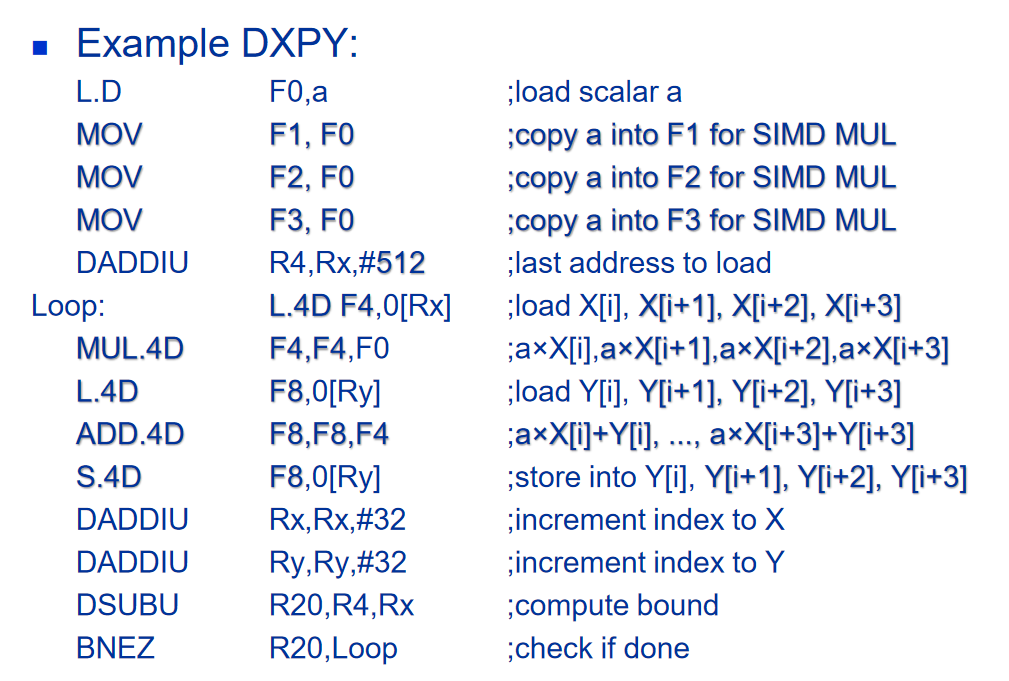
Roofline Performance Model
Basic idea:
Plot peak floating-point throughput as a function of arithmetic intensity
Ties together floating-point performance and memory performance for a target machine
Arithmetic intensity
Floating-point operations per byte read

Fig 4 – Arithmetic intensity
Examples
Attainable GFLOPs/sec Min = (Peak Memory BW ×Arithmetic Intensity, Peak Floating Point Perf.)

Fig 5 - Example
Graphical Processing Units
Given the hardware invested to do graphics well, how can it be supplemented to improve performance of a wider range of applications?
Basic idea:
Heterogeneous execution model
CPU is the host, GPU is the device
Develop a C-like programming language for GPU
Compute Unified Device Architecture (CUDA)
Open CL for vendor-independent language
Unify all forms of GPU parallelism as CUDA thread
Programming model is “Single Instruction Multiple Thread” (SIMT)
Threads and Blocks
A thread is associated with each data element
CUDA threads, with thousands of which being utilized to various styles of parallelism: multithreading, SIMD, MIMD, ILP
Threads are organized into blocks
Thread Blocks: groups of up to 512 elements
Multithreaded SIMD Processor: hardware that executes a whole thread block (32 elements executed per thread at a time)
Blocks are organized into a grid
Blocks are executed independently and in any order
Different blocks cannot communicate directly but can coordinate using atomic memory operations in Global Memory
GPU hardware handles thread management, not applications or OS
A multiprocessor composed of multithreaded SIMD processors
A Thread Block Scheduler
Grid, Threads, and Blocks
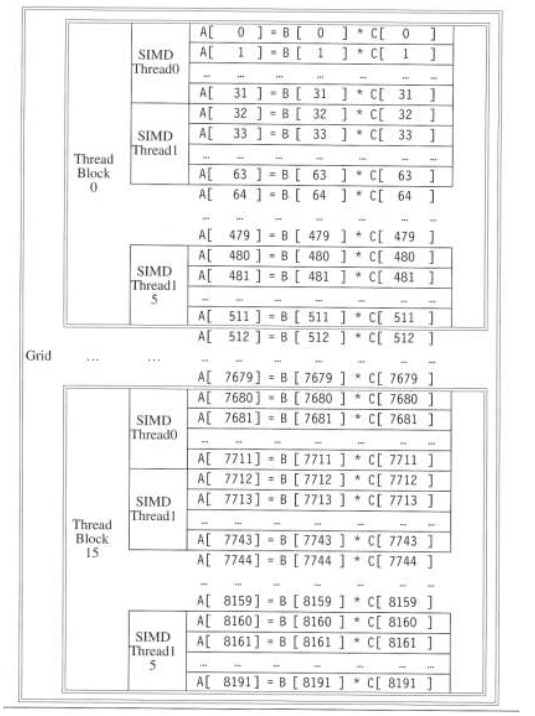
Fig 6 – thread block
NVIDIA GPU Architecture
Similarities to vector machines:
Works well with data-level parallel problems
Scatter-gather transfersMask registers
Large register files
Differences:
No scalar processor
Uses multithreading to hide memory latency
Have many functional units, as opposed to a few deeply pipelined units like a vector processor
Example
Multiply two vectors of length 8192
Code that works over all elements is the grid
Thread blocks break this down into manageable sizes
512 elements/block, 16 SIMD threads/block
32 ele/thread
SIMD instruction executes 32 elements at a time
Thus grid size = 16 blocks
Block is analogous to a strip-mined vector loop with vector length of 32
Block is assigned to a multithreaded SIMD processor by the thread block scheduler
Current-generation GPUs (Fermi) have 7-15 multithreaded SIMD processors

Fig 7 – Floor plan of the Fermi GTX 480 GPU
Terminology
Threads of SIMD instructions
Each has its own PC
Thread scheduler uses scoreboard to dispatch
No data dependencies between threads!
Keeps track of up to 48 threads of SIMD instructions
Hides memory latency
Thread block scheduler schedules blocks to SIMD processors
Within each SIMD processor:
32 SIMD lanes
Wide and shallow compared to vector processors
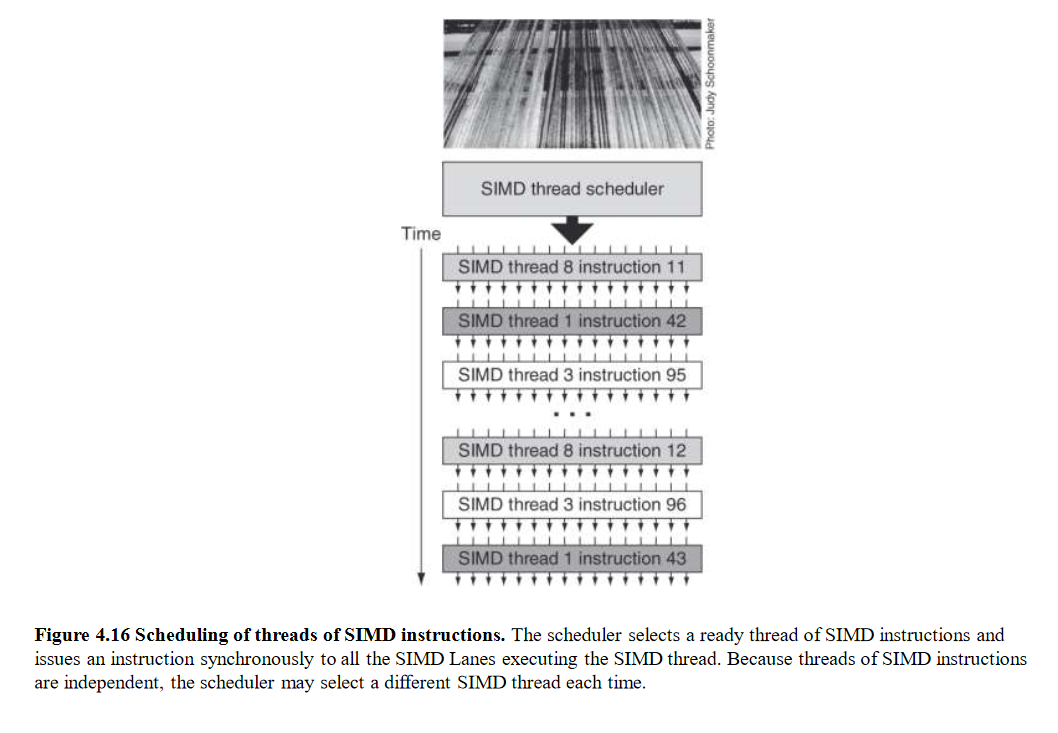
Fig 8 – Scheduling of threads of SIMD instructions
Example
NVIDIA GPU has 32,768 registers
Divided into lanes
Each SIMD thread is limited to 64 registersSIMD thread has up to:
64 vector registers of 32 32-bit elements
32 vector registers of 32 64-bit elements
Fermi has 16 physical SIMD lanes, each containing 2048 registers
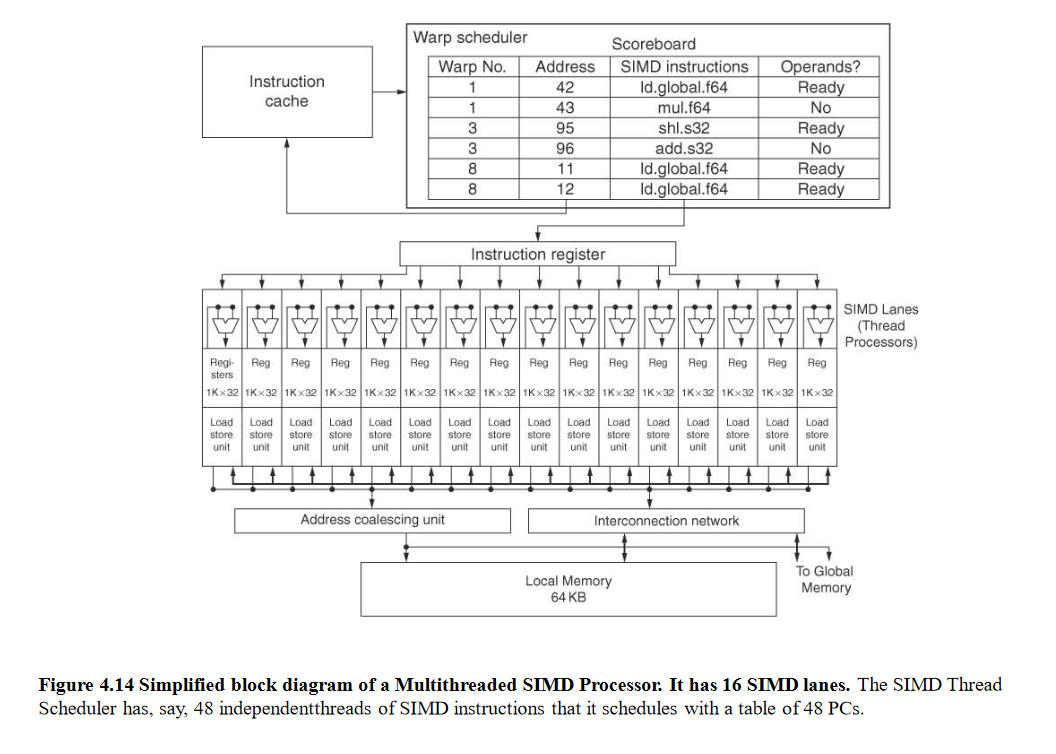
NVIDIA Instruction Set Arch.
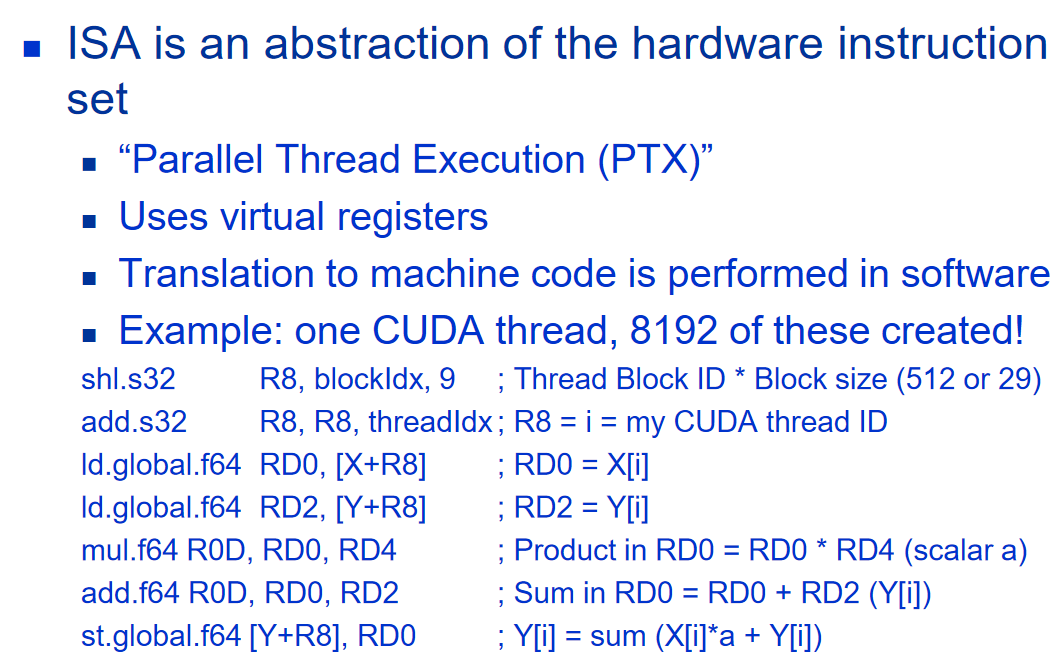
Conditional Branching
Like vector architectures, GPU branch hardware uses internal masks
Also usesBranch synchronization stackEntries consist of masks for each SIMD lane
I.e. which threads commit their results (all threads execute)
Instruction markers to manage when a branch diverges into multiple execution paths
Push on divergent branch
...and when paths converge
Act as barriers
Pops stack
Per-thread-lane 1-bit predicate register, specified by programmer
Example
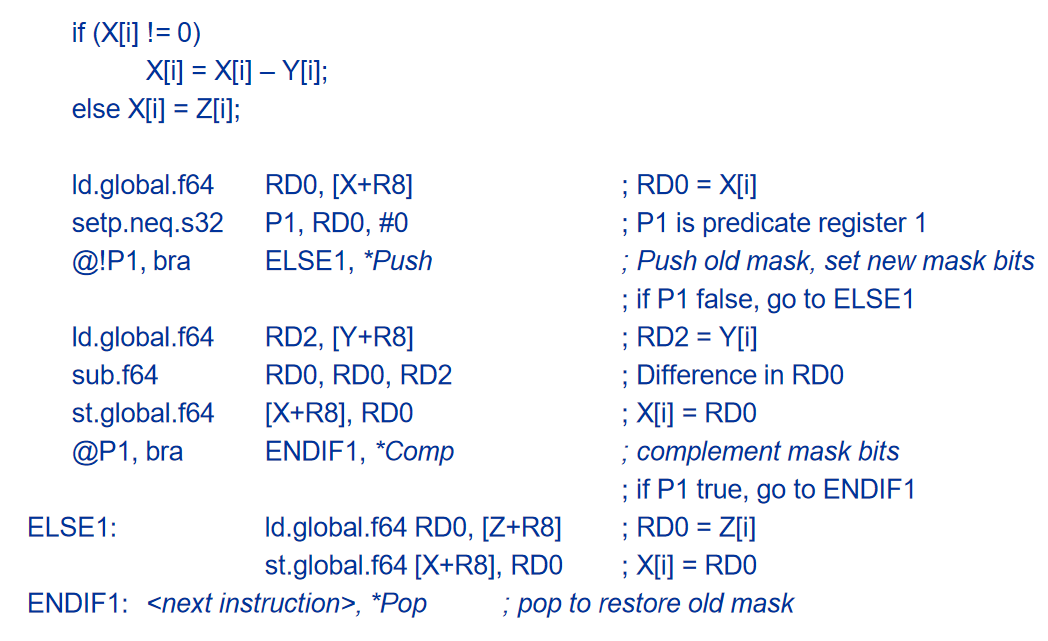
NVIDIA GPU Memory Structures
Each SIMD Lane has private section of off-chip DRAM
“Private memory”, not shared by any other lanes
Contains stack frame, spilling registers, and private variables
Recent GPUs cache this in L1 and L2 caches
Each multithreaded SIMD processor also has local memory that is on-chip
Shared by SIMD lanes / threads within a block only
The off-chip memory shared by SIMD processors is GPU Memory
Host can read and write GPU memory
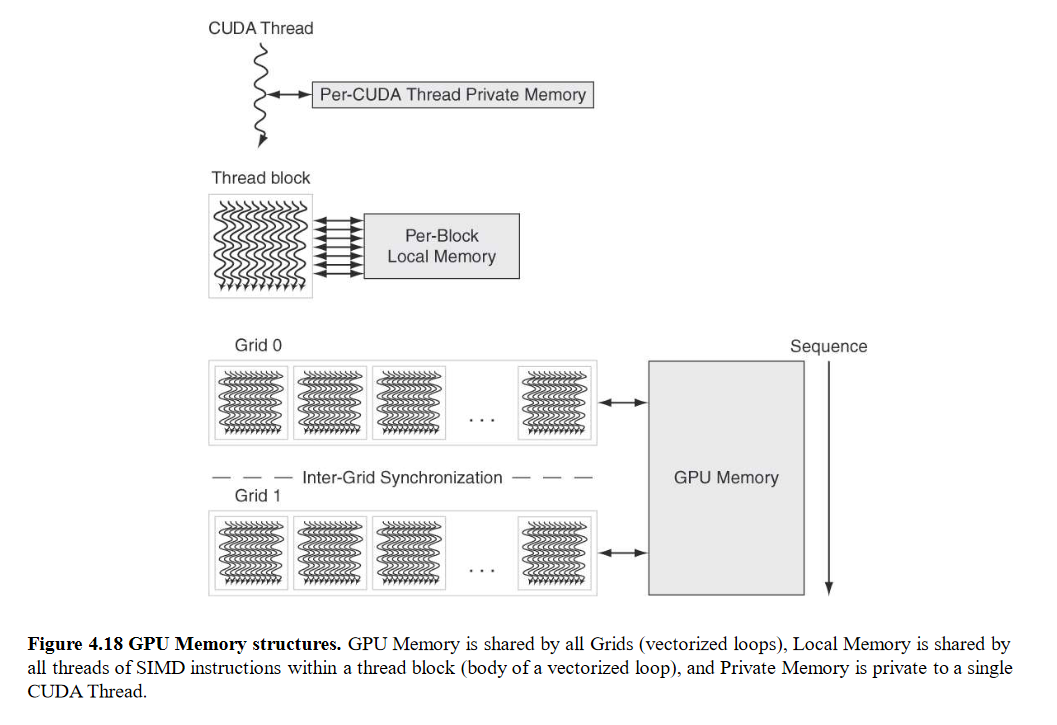
Fig 9 – GPU memory structures
Fermi Architecture Innovations
Each SIMD processor has
Two SIMD thread schedulers, two instruction dispatch units
16 SIMD lanes (SIMD width=32, chime=2 cycles), 16 load-store units, 4 special function units
Thus, two threads of SIMD instructions are scheduled every two clock cycles
Fast double precision: gen-78 515 GFLOPs for DAXPY
Caches for GPU memory: I/D L1/SIMD procand shared L2
64-bit addressing and unified address space: C/C++ ptrs
Error correcting codes: dependability for long-running apps
Faster context switching: hardware support, 10X faster
Faster atomic instructions: 5-20X faster than gen-
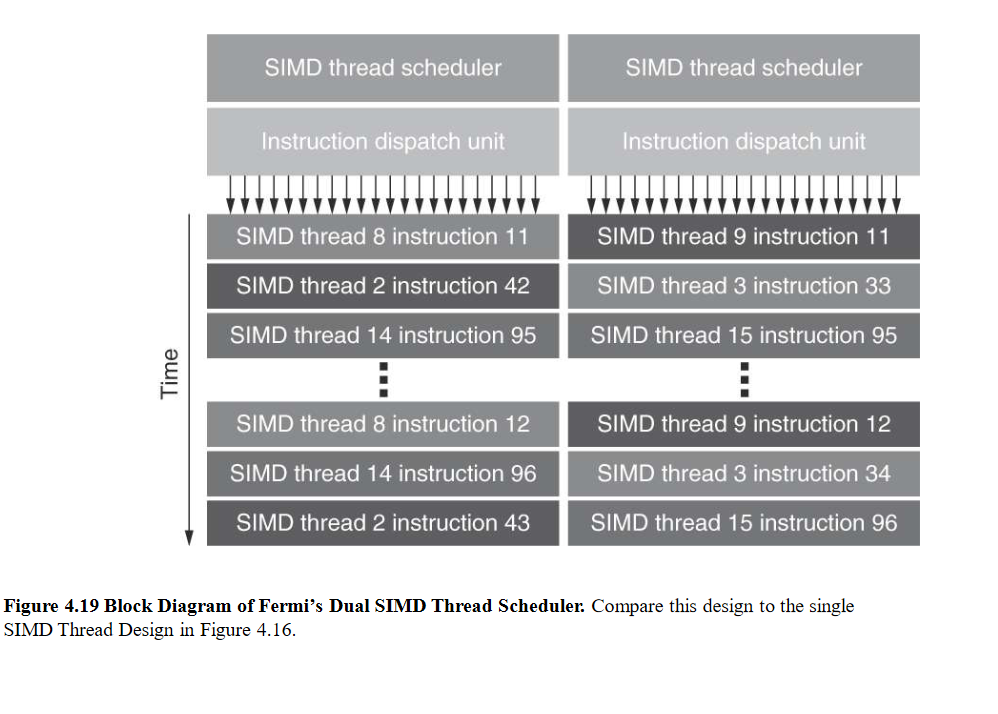
Fig 10 – Fermi dual SIMD thread scheduler
Fermi Multithreaded SIMD Proc.X
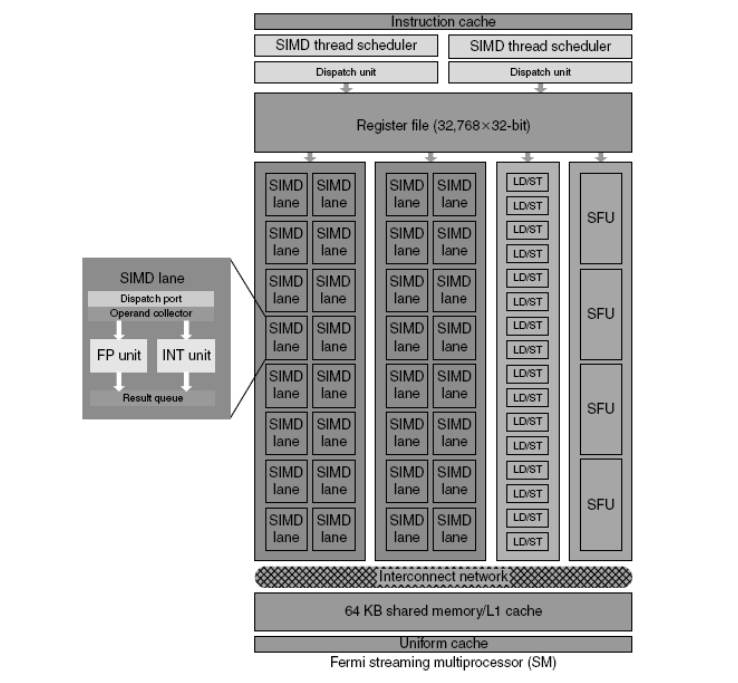
Fig 11 – Fermi streaming multiprocessor
Loop-Level Parallelism
Focuses on determining whether data accesses in later iterations are dependent on data values produced in earlier iterations
Loop-carried dependence
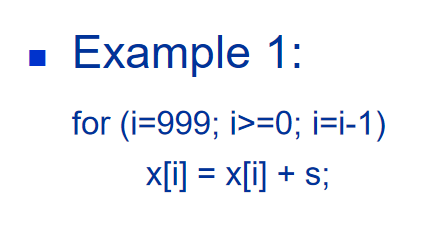
No loop-carried dependence
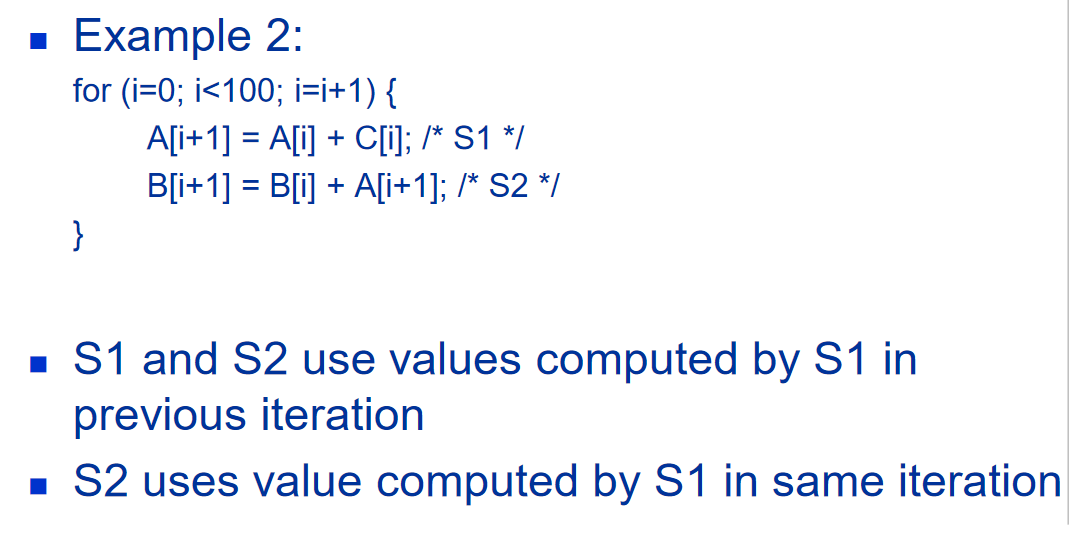
Finding dependencies
Assume that a 1-Darray index is affine:
ax i+ b (with constants and b)
An index in an n-Darray index is affine if it is affine in each dimension
Assume:
Store to ax i+ b, thenLoad from cx i+ d
I runs from m to n
Dependence exists if:
Given j, k such that m≤ j≤ n, m≤ k≤ nStore to ax j+ b, load from ax k+ d, and ax j+ b= cx k+ d
Generally cannot determine at compile time
Test for absence of a dependence:
GCD test:
If a dependency exists, GCD(c,a) must evenly divide (d-b)
Example:for (i=0; i<100; i=i+1) {X[2*i+3] = X[2*i] * 5.0;}Answer: a=2, b=3, c=2, d=0 GCD(c,a)=2, d-b=-3 no dependence possible.
Reductions

Key Takeaway
SIMD architectures can exploit significant data-level parallelism for:
Matrix-oriented scientific computing
Media-oriented image and sound processors
SIMD is more energy efficient than MIMD
Only needs to fetch one instruction per data operation
Makes SIMD attractive for personal mobile devices
SIMD allows programmer to continue to think sequentially
SIMD Parallelism
Vector architectures
SIMD extensions
• Performance: how well scale as increase Proc
• Speedup fixed as well as scaleup of problem
– Assume benchmark of size n on p processors makes sense: how scale benchmark to run on m * p processors?
– Memory-constrained scaling: keeping the amount of memory used per processor constant
– Time-constrained scaling: keeping total execution time, assuming perfect speedup, constant
• Example: 1 hour on 10 P, time ~ O(n3), 100 P?
– Time-constrained scaling: 1 hour, => 101/3n => 2.15n scale up
– Memory-constrained scaling: 10n size => 103/10 => 100X or 100 hours! 10X processors for 100X longer???
– Need to know application well to scale: # iterations, error tolerance
• Multilevel cache hierarchy + multilevel inclusion—every level of cache hierarchy is a subset of next level—then can reduce contention between coherence traffic and processor traffic
– Hard if cache blocks different sizes
• Also issues in memory consistency model and speculation, nonblocking caches, prefetching
Example: Sun Wildfire Prototype
- Use “off-the-self” SMPs as building block
- Gigaplane bus interconnect, 3.2 Gbytes/sec
- WFI board supports one coherent address space across 4 SMPs
- Each WFI has 3 ports connect to up to 3 additional nodes, each with a dual directional 800 MB/sec connection
- Has a directory cache in WFI interface: local or clean OK, otherwise sent to home node
- Multiple bus transactions
Key Takeaway
• Performance: how well scale as increase Proc
• Speedup fixed as well as scaleup of problem
– Assume benchmark of size n on p processors makes sense: how scale benchmark to run on m * p processors?
– Memory-constrained scaling: keeping the amount of memory used per processor constant
– Time-constrained scaling: keeping total execution time, assuming perfect speedup, constant
Text Books:
Reference Books: